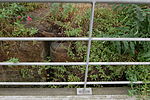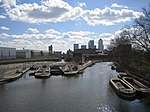Bromley-by-Bow tube station
Bromley-by-BowDistrict line stationsFormer London, Tilbury and Southend Railway stationsHammersmith & City line stationsRail transport stations in London fare zone 2 ... and 4 more
Rail transport stations in London fare zone 3Railway stations in Great Britain opened in 1858Tube stations in the London Borough of Tower HamletsUse British English from August 2012

Bromley-by-Bow is a London Underground station located on the Blackwall Tunnel Northern Approach Road in the Bromley-by-Bow area of London, United Kingdom. The station is below the Blackwall Tunnel Northern Approach Road and lies between Bow Road and West Ham stations on the District and Hammersmith & City lines, and is in both Travelcard Zones 2 and 3.
Excerpt from the Wikipedia article Bromley-by-Bow tube station (License: CC BY-SA 3.0, Authors, Images).Bromley-by-Bow tube station
Twelvetrees Crescent, London Poplar
Geographical coordinates (GPS) Address Nearby Places Show on map
Geographical coordinates (GPS)
| Latitude | Longitude |
|---|---|
| N 51.524 ° | E -0.0113 ° |
Address
Twelvetrees Crescent
Twelvetrees Crescent
E3 3LP London, Poplar
England, United Kingdom
Open on Google Maps









